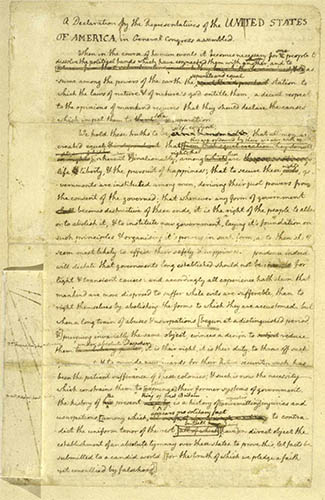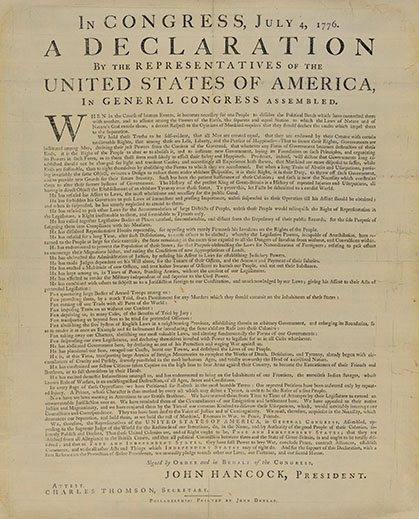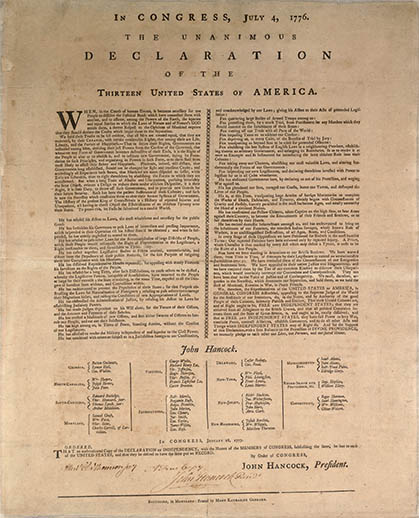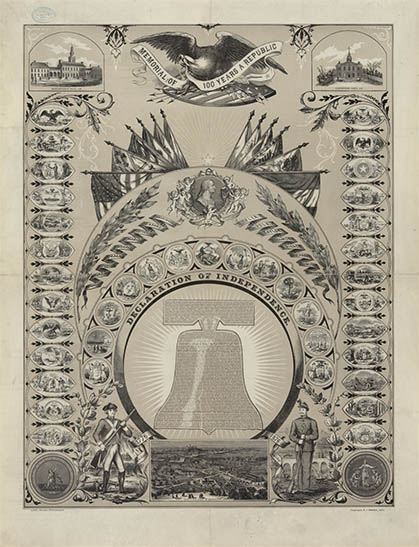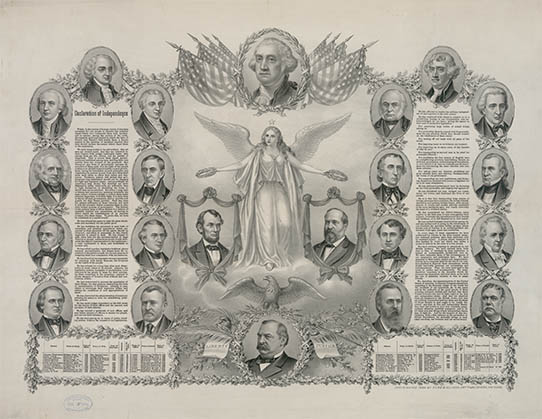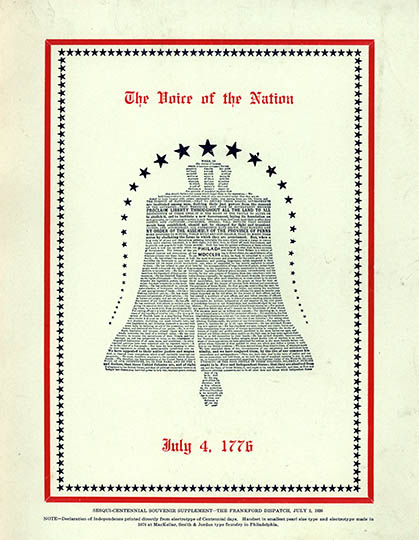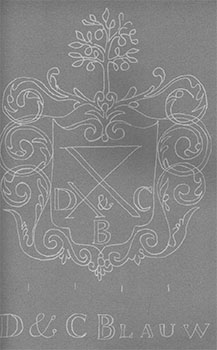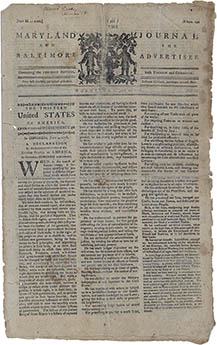98
The Declaration of Independence
Colonial/Victorian Typography and Calligraphy
This is a detail of the current state of the 2 Aug 1776 “engrossed” copy of the Declaration of Independence and, as you can see, it’s not exactly what you were shown in your high-school civics class. As conservator Pauline Maier stated for NOVA, “The document is faded legitimately. It was rolled up and dragged from place to place. It was subject to Stone’s wet pressing process. It was hung across from a bright window in the Patent Office for 35 years. This document has a right to be faded.”
And faded it has become, particularly the signatures, but fortunately it is only one of several Declarations of Independence (a title, BTW, that none of the documents ever carried).
On 7 Jun 1776 Richard Henry Lee presented a resolution to the Second Continental Congress “...that these United Colonies are, and of right ought to be, free and independent States...” There was still no consensus on his resolution when the Congress adjourned on Jun 11, but they appointed a Committee of Five to draft a declaration of independence from England.1
Over the next 17 days Thomas Jefferson prepared a draft, with corrections suggested by Ben Franklin and John Adams:
Jefferson’s “rough draught,” LOC
The Congress reconvened on Mon 1 Jul 1776 and by the next day had ratified Lee’s resolution. They spent all of 3 Jul and the morning of Thur 4 Jul revising Jefferson’s “fair copy” draft of the declaration. They then tasked the Committee of Five to “superintend and correct the press.”
Someone - no one knows who - took the document to the 45 Market Street printing office of John Dunlap, some four blocks from the State House. Dunlap, his compositor and likely several assistants set, proofed and corrected the document and by the next morning had printed some 200 sheets:2
Dunlap Broadside. LOC
The broadside, 19 × 15", with 1360 words set in titling and pica-sized Caslon was, to be kind, not Dunlap’s best work. Swiping corrections left poor word spacing, sheets were crooked on the platen, watermarks were reversed and many of the copies were folded before the ink was dry. As Jefferson wrote in his papers “we were all in great haste.”3
On 17 Jul the Congress resolved “That the Declaration passed on the 4th, be fairly engrossed on parchment.” For the task they chose Secretary Charles Thomson’s assistant Timothy Matlack, who had already engrossed a number of documents for the Congress, including Washington’s 1775 Commission. By 2 Aug he had finished writing the document and over the next several months it was signed by 56 of the delegates.
The 24¼ × 29¾" parchment was engrossed with a quill nib using iron-gall ink. Matlack’s copperplate script, with a 54° slant and emphasis on the downstrokes was derived from contemporary English roundhand and was typical of the formal hands of the Colonial era.4
On 18 Jan 1777, the Congress, then in Baltimore, ordered “That an authenticated copy of the Declaration of Independency, with the names of the members of Congress subscribing the same, be sent to each of the United States...” They commissioned the postmistress, editor, publisher and printer Mary Katherine Goddard to print a copy of the engrossed document.
Goddard Broadside. LOC
The Goddard broadside, 21¼ × 17¼", with text set in two columns of unleaded pica Caslon (~11/12 pt) was the first edition to publicly include all of the current signatories. It was, in every way, a better printing than the Dunlap version. An awesome example of Colonial grrl power.5
After the War of 1812, when nationalistic sentiment was particularly high, several people attempted facsimile versions, including Benjamin Owen Tyler (1818), William Woodruff (1819) and John Binns (1819). Binns even tried to receive the patronage of the Government, but instead Secretary of State John Quincy Adams commissioned an official facsimile from his political ally William J. Stone.
In 1820 Stone, a Washington lithographer, supposedly copied the original using a wet-transfer method, where a sheet of dampened paper was pressed upon the original until a faint ink impression was transferred to the sheet. The process gave Stone a good outline but also irreparably damaged the original.
Stone took three years to etch this copy onto a copper lithographic plate, which fortunately turned out to be remarkably accurate. The plate was purchased by the Department of State and they printed 200 official copies on vellum followed by an edition of several thousand unofficial copies:
The Stone copy is now the defacto official image of the original. It is this version that is reproduced in your history books.
Of course, over the years the Declaration has been printed countless thousands of times, especially around its’ centennial, sesquicentennial and bicentennial, and these prints often used contemporary design and typography. Here are a few examples:
Louis Mercer, 1849. LOC
William Fisk, 1859. LOC
T. J. Berry, 1876. LOC
Kurz and Allison, 1884. LOC
Frankford Dispatch, 1926, from an 1876 electrotype. LOC
1. The committee included John Adams (Massachusetts), Roger Sherman (Connecticut), Benjamin Franklin (Pennsylvania), Robert R. Livingston (New York) and Thomas Jefferson (Virginia). As Jefferson wrote in his papers: the committee “unanimously pressed on myself alone to undertake the draught. I consented; I drew it; but before I reported it to the committee I communicated it separately to Dr. Franklin and Mr. Adams requesting their corrections.”
2. For more information on Jefferson’s “fair copy” and the Dunlap Broadside see: Boyd, Julian. “The Declaration of Independence: The Mystery of the Lost Original.” Pennsylvania Magazine of History and Biography. 1976 Oct;100(4): 438–46. Which is available as a pdf.
3. In May 1975, Frederick Goff conducted a study of all the extant broadsides printed by Dunlap and found that in addition to a printer’s proof, there were two distinct states of printing. He also determined that the broadside was printed on chain-laid paper manufactured by Dirk and Cornelis Blauw of Zaanstreek, Holland, and likely imported by Dunlap from England. See: Goff, Frederick R. The John Dunlap Broadside: The First Printing of the Declaration of Independence. Washington: Library of Congress, 1976. Here is the watermark:
4. For a complete history of the whereabouts and travels of the engrossed copy see: The Declaration of Independence: A History at NARA’s excellent Charters of Freedom.
5. This was not Goddards’s first brush with the DOI. On 10 Jul 1776 she published the text of the Dunlap Broadside on the front page of her newspaper, The Maryland Journal and Baltimore Advertiser:
12 Jul 2011 ‧ Typographia Historia

